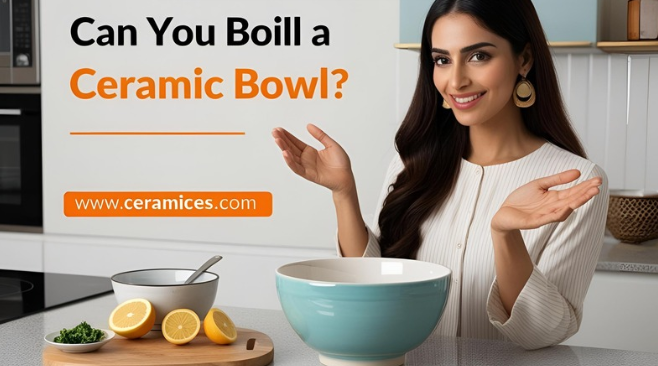Ceramic bowls are a staple in kitchens worldwide, valued for their versatility, aesthetic appeal, and durability. Whether you’re using them for serving, baking, or food storage, ceramic bowls are a reliable choice. However, one question that often arises is, “Can you boil a ceramic bowl?” This article will explore the answer in detail, providing insights into the properties of ceramic, its heat resistance, and how to safely use ceramic bowls in various cooking scenarios. We’ll also address common FAQs and provide tips to ensure your ceramic bowls last for years.
Understanding Ceramic Bowls: Composition and Properties
Before diving into whether you can boil a ceramic bowl, it’s essential to understand what ceramic is made of and how it behaves under different conditions. Ceramic is a non-metallic, inorganic material typically made from clay, which is fired at high temperatures to achieve its final form. The firing process makes ceramic hard and durable, but its properties can vary depending on the type of clay and glaze used.
Key Characteristics of Ceramic Bowls:
- Heat Resistance: Most ceramic bowls are designed to withstand high temperatures, making them suitable for oven use.
- Porosity: Unglazed ceramic is porous, while glazed ceramic has a protective layer that makes it non-porous and easier to clean.
- Durability: Ceramic is sturdy but can be brittle and prone to cracking under sudden temperature changes.
Can You Boil a Ceramic Bowl? The Answer Explained

The short answer is yes, you can boil a ceramic bowl, but with some important caveats. Not all ceramic bowls are created equal, and their ability to withstand boiling temperatures depends on their quality, glaze, and construction.
Factors to Consider Before Boiling a Ceramic Bowl:
- Quality of the Ceramic: High-quality ceramic bowls are more likely to handle boiling water without cracking or breaking.
- Glaze: Glazed ceramic bowls are generally safer to boil because the glaze provides an additional layer of protection.
- Temperature Changes: Rapid temperature changes, such as placing a cold ceramic bowl directly into boiling water, can cause thermal shock and lead to cracking.
How to Safely Boil a Ceramic Bowl:
- Check the Manufacturer’s Instructions: Always refer to the care instructions provided by the manufacturer to ensure the bowl is suitable for boiling.
- Avoid Thermal Shock: Gradually heat the ceramic bowl by placing it in warm water before exposing it to boiling temperatures.
- Use a Heat Source Evenly: Ensure the heat is distributed evenly to prevent localized stress on the ceramic.
Benefits of Using Ceramic Bowls for Boiling
Boiling food or liquids in a ceramic bowl can offer several advantages:
- Even Heat Distribution: Ceramic heats evenly, which is ideal for simmering soups or stews.
- Non-Reactive Material: Ceramic does not react with acidic or alkaline foods, preserving the flavor and quality of your dishes.
- Aesthetic Appeal: Ceramic bowls are visually appealing, making them perfect for serving directly from the stovetop to the table.
Risks of Boiling a Ceramic Bowl
While boiling a ceramic bowl is possible, there are some risks to be aware of:
- Cracking or Breaking: Poor-quality ceramic or sudden temperature changes can cause the bowl to crack.
- Glaze Damage: Repeated exposure to high temperatures can damage the glaze, leading to discoloration or chipping.
- Safety Concerns: A cracked or damaged ceramic bowl can pose safety risks, especially if it breaks during use.
How to Care for Your Ceramic Bowls

Proper care can extend the lifespan of your ceramic bowls and ensure they remain safe to use. Here are some tips:
- Avoid Extreme Temperature Changes: Always allow your ceramic bowls to adjust to room temperature before exposing them to heat or cold.
- Hand Wash When Possible: While many ceramic bowls are dishwasher-safe, hand washing can help preserve the glaze.
- Inspect for Damage: Regularly check your ceramic bowls for cracks or chips, as damaged bowls are more likely to break under stress.
FAQs About Boiling Ceramic Bowls
1. Can all ceramic bowls withstand boiling water?
Not all ceramic bowls are designed to handle boiling water. High-quality, glazed ceramic bowls are more likely to withstand high temperatures, but it’s essential to check the manufacturer’s guidelines.
2. What happens if I boil a low-quality ceramic bowl?
Boiling a low-quality ceramic bowl can cause it to crack, break, or even shatter due to thermal shock or insufficient heat resistance.
3. Can I use a ceramic bowl on a stovetop?
Most ceramic bowls are not designed for direct stovetop use. However, some ceramic cookware is specifically made for stovetop cooking. Always check the manufacturer’s instructions.
4. How can I tell if my ceramic bowl is heat-resistant?
Look for labels or markings indicating that the bowl is oven-safe or heat-resistant. If unsure, contact the manufacturer for clarification.
5. Is it safe to boil a ceramic bowl in the microwave?
Yes, most microwave-safe ceramic bowls can handle boiling liquids. However, avoid sudden temperature changes, such as transferring a cold bowl directly into the microwave.
6. Can boiling damage the glaze on a ceramic bowl?
Repeated boiling can wear down the glaze over time, leading to discoloration or chipping. To minimize damage, avoid prolonged exposure to high temperatures.
7. What should I do if my ceramic bowl cracks while boiling?
If your ceramic bowl cracks, stop using it immediately. Cracks can harbor bacteria and increase the risk of the bowl breaking during use.
8. Are there any alternatives to boiling in a ceramic bowl?
If you’re concerned about boiling in a ceramic bowl, consider using stainless steel, glass, or enameled cookware, which are more resistant to thermal shock.
9. Can I boil a ceramic bowl with food in it?
Yes, you can boil a ceramic bowl with food, but ensure the bowl is heat-resistant and avoid sudden temperature changes.
10. How long can I boil a ceramic bowl?
There’s no specific time limit, but prolonged boiling can increase the risk of damage. Monitor the bowl for signs of wear, such as cracks or glaze damage.
Conclusion
So, can you boil a ceramic bowl? The answer is yes, but it requires caution and proper care. High-quality, glazed ceramic bowls are generally safe for boiling, but it’s crucial to avoid thermal shock and follow the manufacturer’s guidelines. By understanding the properties of ceramic and taking the necessary precautions, you can safely use your ceramic bowls for a variety of cooking tasks.
Whether you’re simmering a hearty soup or reheating leftovers, ceramic bowls offer a versatile and aesthetically pleasing option for your kitchen. Just remember to handle them with care, and they’ll serve you well for years to come. If you’re ever in doubt, opt for alternative cookware to ensure your safety and the longevity of your kitchen tools.
By following the tips and insights shared in this article, you can confidently use your ceramic bowls for boiling and other cooking tasks, knowing you’re making the most of their unique properties. Happy cooking!
Read more
1 Can You Bake Ceramic in an Oven? Guide to Oven-Safe Ceramics
2 Can I Paint Ceramic Tile? A Guide to Painting Ceramic Tiles
3 Can Ceramic Be Recycled with Glass? Recycling Ceramics and Glass